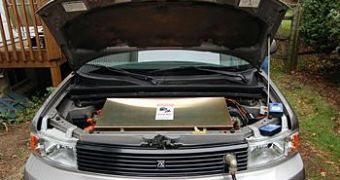At least that's what researchers from the University of Delaware say. By using a electric car prototype produced by the company AC Propulsion, energy stored in the car when recharging, could be used as a output, and returned directly into the power grid when it is needed.
A single such car, would not make a very big difference in case the energy grid need a surplus of energy, however, the researchers believe that if hundreds or thousands of similar cars do the same, the effect would improve significantly the power distribution efficiency. Most of the cars currently present of the U.S. roads, are only driven for a hour every day. But fossil fuel powered cars are mostly useless when they are not on the road, unlike all-electric and hybrid cars which could act as batteries while idling, through a system designed by Willet Kempton called vehicle-to-grid or V2G for short.
The cost of storing the excess electric power produced in the U.S. and U.K., translates in a storing capacity of only 1 percent of the excess electric energy. So the energy companies trying to supply the demand, provide with extra storage facilities to gather the energy which would usually go to waste. This is especially important when the electric energy is produced by renewable, alternative power sources such as the light coming form the Sun, or tidal power the most of the time is produced in a irregular way.
The most popular mean of storing the extra energy produced, is to pump water in uphill reservoirs, and use it to produce electric energy when it is needed. The power demand usually reaches a spike during the 4 am and 7 am hours, when the energy demand grows as people, or factories start to draw power from the grid, and power plants need to increase the power output to cope with the demand.
On board computers in the car, using a so-called "broadband-over-powerlines", relays information through the power cables, to create a secure connection with a computer at the grid operator PJM. The two computers exchange information related to the state of the power stored in the car, and determine whether to charge up or to output power in the grid, depending of the power spikes, to smooth the supply of power circulated through the grid.
Estimates on the amount of energy saved this way, reveals that each car could contribute with a 4000 dollars worth of store energy a year, out of which 600 dollars would represent the value of the power connection kit required for such operation. Kempton believes, that the power companies could encourage the costumers to use this system by sharing with them some of the energy savings.
Meanwhile, in the next year and a half, the researchers have in plan to build at least four cars, and the software the would control the system.

 14 DAY TRIAL //
14 DAY TRIAL //